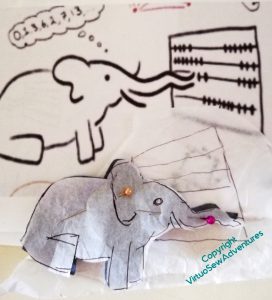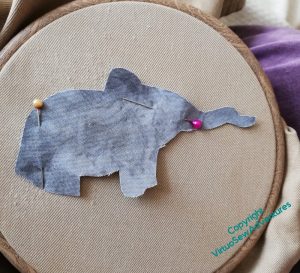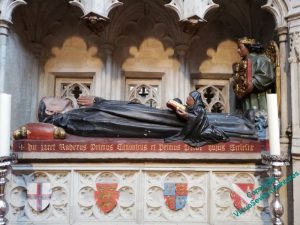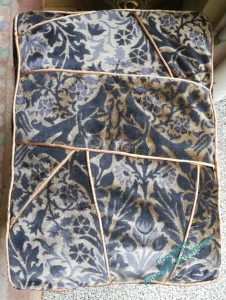Category: General Embroidery
Mending with a Mathstodon
We noticed recently that there was an unexpected hole in a pair of The Australian’s trousers. Unexpected, because above the knee, nowhere near a pocket, and the surrounding fabric was in better condition than the hole would suggest.
I am sure I couldn’t achieve an invisible mend on a fine cotton twill such as this, so then it became a matter of considering Visible Mending – making the whole thing look deliberate and considered, rather than pulled together any old how. So, I asked, what sort of patch would you like?
Which is how I came to be messaging The Australian’s co-moderator on the Mastodon instance, “Mathstodon.xyz”, to ask for permission to use the header/logo image he had sketched as the basis for an embroidered patch.
I did think of using the whole thing, embroidered on a larger piece of cloth, but I felt it would make the trousers a bit uncomfortable, so I am extracting the Mathstodon himself, and his counting frame, and I can always add more diagrams and formulae if the trousers wear in other places…
I wouldn’t normally use a hoop when I’m mending a pair of trousers, but it did make it much easier to keep track of where the darned bit was.
The Mathstodon himself is cut out of grey quilting cotton with a slightly marbled print, and I’m going to attach him conventionally over the darn, first held in place with small running stitches and then with buttonhole stitch around his edge, and a few extra details on the inside.
More on Mother Julian and Rahere
I have a steadily extending bookshelf of reference material. Not all useful, alas, but in this stage I never know what is useful until I get there, so I just have to keep reading.
I’m trying to plan the borders for my planned pieces – these are companions for William Marshall, after all, so the basic style of the designs needs to match his. So, for example, since Julian of Norwich and Rahere are both clerical figures, at least to a degree, maybe I can take into account the information that the “lilies of the field” mentioned in the Bible are probably Lilium candidum, which is native to the Holy Land. Perhaps I could include them, and scallop shells (emblems of pilgrimage), and maybe London Pride (scabious urbanum?) for Rahere? Or maybe lavender or one of the healing herbs? And for Julian, the lilies of the field with hazel leaves and nuts?
I’ve started also to think about the designs themselves. Among the references I’ve not shown in that picture, I have a book of Psalms illustrated with a variety of artwork from the medieval and renaissance period. The illustrations weren’t chosen with my needs in mind, of course, so this rather scrappy effort for Julian is based on a combination of several. I’d like to have a better drapery effect when I get there, although I have to be careful not to be too exaggerated – I can’t imagine anchoresses dressed in the height of fashion!
For Rahere, I can use the drawing of the effigy on his tomb as the basis, but in his hands will be a model of the Priory and Hospital of St Bartholomew The Great, and at his feet the jester’s cap symbolising the life he rejected after the loss of The White Ship. I may have building work behind him, the beginning of a tower or a wall.
When I made my first research visit to St Bartholomew’s, I didn’t look at the outside, which may prove to be a mistake. Fortunately I am sure I will get another chance to visit!
By contrast, when I visited Mother Julian’s Church, I didn’t do a sketch inside her cell – that would have involved being terribly in the way for the people preparing for a Flower Festival later in the week. I sat in the churchyard and painted the outside, instead. Norwich is a bit more of an epic to get to from the west coast, where we are, so I may have to be Even More Imaginative for Mother Julian’s surroundings!
Researching Rahere..
It’s going to be some while before I can start stitching on the other Medieval Movers and Shakers (I’m going to have to find a better title for that quartet, they’re going to drive me demented if I don’t!), but given I have much research to do, that’s no great difficulty.
I have been accumulating books – which is also rather a delight in any case.
The history of the church Rahere founded duly arrived a week or so after our visit, and proved very interesting indeed. It included among the illustrations this engraving of the tomb effigy on Rahere’s tomb. The tomb was not made for Rahere when he died, but about four hundred years later, so one should take the likeness of the face with a pinch of salt, but I’m sure it will have got his Dominican robes right, so it may be useful in planning how I depict him. (I’ve just double checked – white cassock and black cloak, so for the purposes of the embroidery I can go for the look of undyed wool for the cassock, and dark greys and browns for the cloak).
I also found a reference to an epic poem called The Romance of Rahere, thinking it might at least be atmospheric.
Well, no. It’s set in the Civil War, about the orphan daughter of the vicar of St Bartholomew the Great who is named after the founder (poor lass) and who dies in the church during a thunderstorm, leaving the boy who wants to marry her absolutely distraught, and becoming a soldier to seek death, but surviving and returning home to right the wrongs caused by his greedy and abusive father.
So not even remotely helpful!
In the Kipling tale in which he appears, “The Tree of Justice”, Rahere, the Kings’ Jester, is described as: “more of a priest than a fool and more of a wizard than either“, and his jester’s outfit as parti-coloured in black and red. There is so little information about the person that I’m going to be using that as the basis for my characterisation. My current idea for the embroidery design is to have Rahere in his Dominican Robes, with a model of St Bartholomew the Great in his hands, and his jester’s cap at his feet. The border – well, maybe the flower London Pride, maybe bells (for the jester) and scallop shells (for pilgrimage). We’ll just have to wait and see!
Beginning The Knot Garden
A “Site Visit” recently gave me the chance to look at my wools in the room for which the cushion is destined, and to talk to my cousin about the whole thing. It also provided a reminder of the truism that, no matter how extensive the stash, for any particular project, the stash will prove inadequate!
I had my experimental panel with me, and one of the things my cousin said was that she was not particularly taken with the effect of the tent stitches or straight stitches infilling between the pattern stitches. I agreed that it looked a bit clunky and congested, so when I got home again, I got out my acrylic paints and painted the canvas, just the area of the borders.
What I have done is to use three different shades of brown, solo and in mixtures. And I’ve painted both sides of the canvas, to make the coverage a bit more thorough. This way, I’m not trying to produce an absolutely flat colour, as though the canvas were dyed or coloured from the start.
You can also see in this picture that the “pathways” spill out into the surrounding canvas. I was intending the stitching to do so as well, but there’s an old saying in military circles, that “No plan survives contact with the enemy”. I would adapt that for stitchers – I don’t regard the canvas as my enemy, but no plan survives the first stitching session unchanged!
I started to work the Parisian Stitch border around the beds, using two different colours of crewel wool in the needle, and soon decided that although I want to have a couple of rows of tent stitch around the outside, to help with adding the back to the cushion, I also want the pattern area properly delimited. So the line between the beds will be filled with a line of Parisian stitch as well.
Another decision to make!
Underside couching, I’ve decided, is rather like satin stitch. In concept it is simple, not to say obvious. The execution, accurately and aesthetically, is very much less so!
I had intended to use the gold thread left over from the Amarna Family Group as my thread for William’s background, in the interests of economy, if nothing else, but then I had advice from Tanya Bentham and others, to at least try the Smooth Passing, which might for a multitude of reasons behave rather better.
So here you see the second practice block started, again using silver, but this time smooth passing thread.
The passing thread is, as suggested, much pleasanter to use, and creates a smoother and less shadowed surface, which in turn, I think, should help the pattern I intend to use. Which, you may note, I’ve not yet got around to practicing!
However, that brings me to my decision. I do not think that I can be certain that the spool of Gold Smooth Passing I have left over from a Thistle Threads project will finish the job, so I shall have to buy some smooth passing. And it turns out that Gold comes in more than one shade!

The decisions are never at an end, are they…
And since I’m working on pulling the Amarna pieces together properly at present, I can’t claim to be giving my whole mind to the decision-making!
Researching Rahere

A journey through London gave me the opportunity to visit the Church of St Bartholomew The Great in Smithfield, which is indeed very close to the Hospital Rahere founded, known today as St Barts.
It, and Rahere himself, have had varying fortunes and visibility over the years, and, for example, Rahere’s tomb was built in the fifteenth century, nearly four centuries after his death.
I haven’t yet discovered whose shields are displayed there, but it seems likely I will. The Rector was involved in a wedding rehearsal when I arrived, but I carried on quietly sketching and walking around the Church, staying out of the way as best I could while still continuing to work.
And I had my reward in due course, when, on the principle that Bairns As Don’t Ask, Don’t Get, I tracked him down afterwards and asked what, if any, information they had on Rahere and the early days of his foundation.
I may have bewildered him slightly – I have the impression that’s not the first thing people usually say! – but he took it well, and informed me that as this year is the anniversary of the foundation, a substantial History has been produced. So when that arrives, I shall have more to say on the subject, I’m sure!
Stella’s Birds – more thinking about the design
You may recall that I said last time I mentioned the design I am trying to work out here, that it was proving very difficult to balance three birds not looking the same way, and that making them look the same way didn’t work at all.
Then it occurred to me that – obviously! – the two earlier birds would be facing towards the one that’s singing. Partly because we always turn to look where the noise is coming from, and partly because that is their aspiration.
You will notice that all of the rough designs I’m playing with here are in colour, which is not at all in keeping with my idea of using Mountmellick work. That’s because at present I want to find it easy to distinguish parts of the design. When I’m a little clearer about the shapes and their flow, I’ll start moving towards a more tonal patterning that will help me to think about stitch choice.
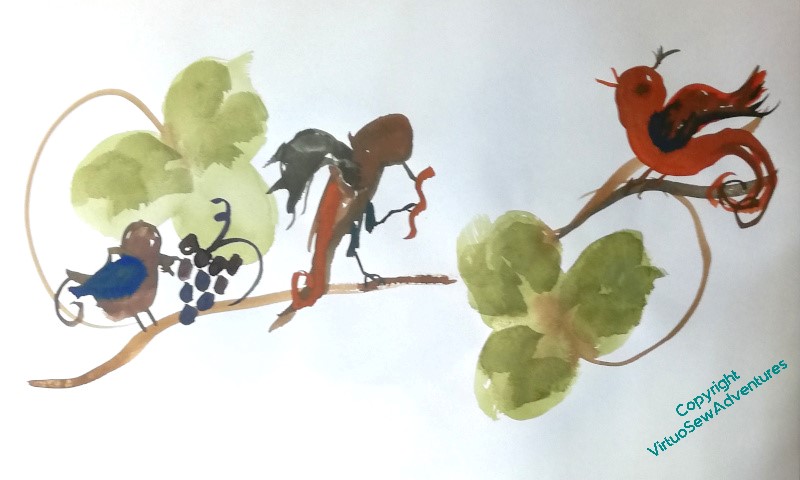

In the meantime, I am playing with shapes and layout in very vague terms.


Eventually, I want the birds to be quite medieval and slightly mad in appearance, and I’m thinking of trying to find some suitable thread – a round, matte cotton in two or three thicknesses – in a variegated colour that will help me to create the look of carved wood. The challenge is in finding it. This is not something easily bought online with any confidence, and so many of the thread companies don’t go to the shows anymore.
Coronation Stitchery
Since I did, in fact, manage to finish the traycloth I found half-begun, which I believe was designed for the late Queen’s Coronation in 1953, within her reign (if only by a few weeks), I thought I should do something in stitchery to commemorate the Coronation of King Charles III.
Nothing of the quality of those beautiful screens, or any of the other stitching (I can’t have been the only person muttering, “I want to hear more about the embroidery!”), but something simple, embroidery in the hand, like this traycloth, a return to my stitching roots.
I’ve not really had the time, or the ideas, frankly (too much else cluttering up the “designs” part of my head!) to develop anything of my own, but since the Palace had gone to the trouble of creating a rather charming Coronation logo, making use of the heraldic flowers of the United Kingdom to bring together the nations, and the King’s well-known love for the natural world, I decided to take elements from that, and put them together into a traycloth or runner.
The crown is in the centre of one short side, and I’ll put His Majesty’s cipher at the other end.
The long sides are going to be decorated with more elements from the Coronation logo. It’s all very simple stitchery, but it has been an excellent companion to the Coronation itself, and to Patrick Grant’s wonderful documentary about Kashket’s, Hainsworth’s, and the other companies involved in making elements for the Coronation.
That documentary made me positively homesick for my postgraduate days, visiting spinning mills in Lancashire and Yorkshire, surrounded by the smell of wool, and the passion and dedication of the people working in the mills. It’s an odd thing, but I’ve never met a cynic in the textile industry. People who are anxious about the future, yes, concerned about loss of skills, yes. But none of them pretend not to care, and if you show any interest, their eyes light up, and soon you are engulfed in a great flood of enthusiasm, knowledge and ideas.
Yes, I know what people say about dour Yorkshiremen. That wasn’t my experience of them, not at all!
Mending, Upcycling, and other adventures
As a family, we have always made and remade, mended and upcycled, garments, furnishing and furniture. There is a tale of five year old me, accompanying my mother to buy fabric for a dress in the now long-gone and much-lamented fabric shop in town, and piping up, as she was paying, to ask “What will it be _next_?”, so you can tell this is deeply ingrained!
Usually this is something I let pass without comment, but two episodes lately seemed worth mentioning, in case they give someone else an idea..
The Japanese mending technique for pottery, “kintsugi”, involves highlighting the mends with gold, so as not to obliterate the history of a piece. I can’t say I’m very good at it, but I had an entertaining afternoon with a kit that enabled me to play with the idea, at least.
And then my cousin mentioned a footstool she had with an entirely unsuitable cover for the surroundings, and a few oddments of furnishing fabric from earlier work on the room. Cue a Kintsugi-inspired crazy patchwork footstool cover, with all the seams emphasized with gold piping! This took some work and collaboration, as my sewing machine isn’t up to the task, but Mam’s was.
And on an entirely different scale – one of the problems with older knitwear is the way the ribbed cuffs seem to lose all their elasticity, and what was once a trim and neat shape, will often become shapeless and saggy with age. I’ve tried in the past adding elastic, but I couldn’t make that work (if anyone has – what’s your trick?), so it rather nags at me.
Then this winter we made a dress with rather extravagantly tucked sleeves, and I thought I had an idea that might work. I’ve created an inverted box pleat in the cuff here – it’s just held with stranded cotton at present, something that will show up so I can play with it until it works, and then do it properly (or not!) – and held it together, starting at the sleeve end, with crossing stitches. Then I caught down the side of the box pleat.
You can see in this picture how the cuff is now neat and close, and the sleeve has a bit more shape, and rather less “flop”. I’m very pleased with that, and I may extend this to other, similar garments.
Practice Beforehand

The crosses in place, and the whole border looking very much like a Book of Hours, or at least, a rather tame Book of Hours, I sat back and drew breath.
Having got William and his border done, and being really very pleased with how he’s turned out, I now need to tackle the sky. And from the first, I have intended the sky to be in basketweave pattern underside couching, which is an entirely new technique to me.
Regular readers may have spotted that I only rarely practice beforehand, regardless of the technique, preferring to throw myself headlong into the novelty, mind concentrated by terror. The exception tends to be in goldwork, when an exception occurs, and indeed, I had some of the fabric stretched in a frame, ready to practice, well before I had got William to that stage of finishing. Mindful of the advice from Tanya Bentham’s Opus Anglicanum book, however, I decided not to try practicing while I was still working the silk. In winter it is hard enough to keep the hands from catching on silk without making it worse by using metal threads!
I’m using silver for my practice pieces. One could practice with silk, or pearl cotton, but they would both spread and cover any failure to keep the lines close. I think this silver is the same size as the gold I intend to use, so it will make a better practice material.
It’s easy enough to understand the principle underlying underside couching, but there are all sorts of hazards, As always, I suspect that once the management of the thread becomes second nature, all the difficulties will fall away, but packing the thread closely without cramming, making sure the stitches lie happily on the surface, and stopping the couching thread (a sturdy linen, beeswaxed before use) from showing, are all proving challenging at present.
I am determined to practice this properly, so I’m going to do this inch-wide strip before even considering practicing the basketweave pattern.
I have been looking further at Ko-fi, and how it might be used as a shop front, at least for digital items, and as an experiment, I’ve uploaded the Hug For A Handbag instructions to my Ko-fi Shop as a free/pay what you feel download. If anyone would like to go through the process and tell me what it’s like, and give me the opportunity to see what happens from this side, I’d be very grateful!


